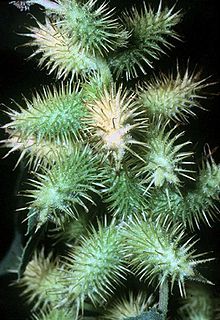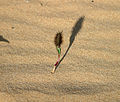- Xanthium strumarium
-
Xanthium 
Xanthium strumarium Scientific classification Kingdom: Plantae Subkingdom: Tracheobionta Division: Magnoliophyta Class: Magnoliopsida Subclass: Asteridae Order: Asterales Family: Asteraceae Subfamily: Asteroideae Tribe: Heliantheae Genus: Xanthium Species: Xanthium strumarium Binomial name Xanthium strumarium
L., 1753Subspecies - Xanthium strumarium canadense
- Xanthium strumarium glabratum
- Xanthium strumarium strumarium
Synonyms Xanthium orientale
Xanthium strumarium (syn. X. canadense, X. chinense, X. glabratum, Rough Cocklebur, Clotbur, Common Cocklebur, Large Cocklebur, Woolgarie Bur) is a species of annual plants belonging to the Asteraceae family. [1] It probably originates in North America and has been extensively naturalized elsewhere.[2] [3]
Contents
Reproductive Biology
The species is monoecious, with the flowers borne in separate unisexual heads: staminate (male) heads situated above the pistillate (female) heads in the inflorescence.[4] The pistillate heads consist of two pistillate flowers surrounded by a spiny [involucre]. Upon fruiting, these two flowers ripen into two brown to black achenes and they are completely enveloped by the involucre, which becomes a [bur]. The bur, being bouyant, easily disperses in the water for plants growing along waterways. However, the bur, with its hooked projections, is obviously adapted to dispersal via mammals by becoming entangled in their hair. Once dispersed and deposited on the ground, typically one of the seeds germinates and the plants grows out of the bur.
Toxic or Medicinal Phytochemistry
The plant may have some medicinal properties[5] and has been used in traditional medicine in South Asia and traditional Chinese medicine. In Telugu, this plant is called by name Marula Matangi.
However, while small quantities of parts of the mature plants may be consumed, the seeds and seedlings should not be eaten in large quantities because they contain significant concentrations of an extremely toxic chemical, carboxyatratyloside. The mature plant also contains at least four other toxins.[6]
- Animals have also been known to die after eating the plants.
- A patient consuming a traditional Chinese medicine containing cocklebur, called Cang Er Zi Wan developed muscle spasms. [7]
- It was responsible for the deaths of at least 19 deaths and 76 illnesses in Sylhet District, Bangladesh, 2007. People ate large amounts of the plants, locally called ghagra shak, because they were starving during a monsoon flood and no other plants were available. The symptoms included vomiting and altered mental states, followed by unconsciousness. [8]
Gallery
References
- ^ Everitt, J.H.; Lonard, R.L., Little, C.R. (2007). Weeds in South Texas and Northern Mexico. Lubbock: Texas Tech University Press. ISBN 0-89672-614-2.
- ^ Atlas of Florida Vascular Plants (English)
- ^ Calflora Taxon Report 8367 Xanthium strumarium L.
- ^ Weaver, S.E.; Lechowicz, M.J. (1982). The biology of Canadian weeds. 56. 'Xanthium strumarium' L.. 'Canadian Journal of Plant Science'.
- ^ Kamboj Anjoo, Saluja Ajay Kumar "Phytopharmacological review of Xanthium strumarium L. (Cocklebur) 2010 | Volume: 4 | Issue Number: 3 | Page: 129-139
- ^ Islam, MR; Uddin MZ, Rahman MS, Tutul E, Rahman MZ, Hassan MA, Faiz MA, Hossain M, Hussain M, Rashid MA. (Dec 2009). "Ethnobotanical, phytochemical and toxicological studies of Xanthium strumarium L". Bangladesh Medical Research Council bulletin 35 (3): 84–90. PMID 20922910.
- ^ West, PL; Mckeown NJ, Hendrickson RG. (2010 May). "Muscle spasm associated with therapeutic use of Cang Er Zi Wan.". Clinical toxicology 48 (4): 380–4. PMID 20521353.
- ^ Gurley, ES; Rahman M, Hossain MJ, Nahar N, Faiz MA, Islam N, Sultana R, Khatun S, Uddin MZ, Haider MS, Islam MS, Ahmed BN, Rahman MW, Mondal UK, Luby SP.. "Fatal outbreak from consuming Xanthium strumarium seedlings during time of food scarcity in northeastern Bangladesh.". PLoS One 5 (3): e9756. doi:10.1371/journal.pone.0009756. PMID 20305785. http://www.plosone.org/article/info%3Adoi%2F10.1371%2Fjournal.pone.0009756. Retrieved 2011 June 07.

This Heliantheae article is a stub. You can help Wikipedia by expanding it.



